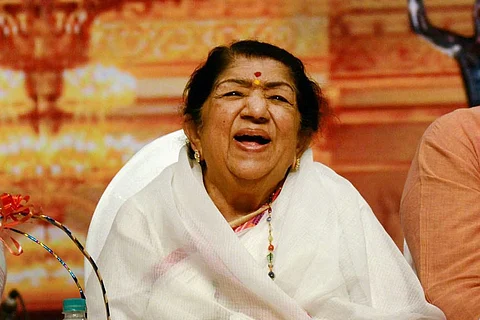

“When you are talking about Michaelangelo, Beethoven or Shakespeare, the greatness lies in their names. Lata Mangeshkar’s name too, says all that has to be said. There is no other word that can encapsulate her,” poet and lyricist Javed Akhtar once said while introducing the singer. As condolences pour in from different parts of the country honouring the 92-year-old singer’s life and work after her demise on February 6, we revisit some of her classics.
In an illustrious career spanning over eight decades, the singer, whose contribution to Indian film music remains unparalleled, has sung innumerable tracks in 36 languages.
“I used to sit on the kitchen shelf and sing as my mother cooked. I would sing the bandish (compositions) my father would teach his students or KL Saigal’s songs that I was quite fond of at that time,” Lata Mangeshkar fondly recounted in an interview. Her singing journey started at the age of five in a household where life was imbued with music. Lata had stated in some of her interviews that she would have pursued a career in classical music had she not been entrusted with the responsibility of becoming the breadwinner of the household at the age of 13 after her father passed away.
Her tryst with south Indian film music dates back to 1955 when she rendered her voice for her first Telugu song. When Lata reportedly spoke to film magazine Kinema in 1954 about her interest in singing in Telugu owing to the fact that the phonetics of the language bore a striking resemblance to Marathi, music composer Susarla Dakshinamurthy promptly reached out to her for the film Santhaanam (1955). Interestingly, it was not the first time Susarla teamed up with Lata. The singer-composer duo had also joined hands for two songs in Sinhala language for the film Seda Sulang (1955).
Lata’s mellifluous rendition of the melancholic and soothing lullaby ‘Nidurapora Thammuda’ was integral to the plot of Akkineni Nageswara Rao and Savitri starrer Santhaanam. Three different variations of the track played out in the film. In the most popular variation, the visuals corresponding to the song feature a young girl putting her toddler brother to sleep with her lullaby. Needless to say, the soul-stirring composition remained popular in the subsequent decades too.
Incidentally, her second Telugu song, ‘Cheeraku Thakadhimi’, from Aakhari Poratam (1988), a duet set to tune by Maestro Ilaiyaraaja that she sung with the late legendary singer SP Balasubrahmanyam, starred Nageswara Rao’s son actor Nagarjuna in the lead.
Her stint in the Kannada and Malayalam music industry, though brief, left a memorable mark too. The line Meri Aawaz hi Pehchan Hai sung by Lata in lyricist Gulzar’s Naam Goom Jayega beautifully surmises that it was not Lata’s linguistic prowess, but her voice that became her identity.
The Bharat Ratna awardee sang her first Kannada song ‘Bellane Belagayitu’ in 1967 in the film Krantiveera Sangolli Rayanna. The song remains etched in the memories of Kannadigas for not just its timelessness, but also because it was the film that roped in her sisters, singers Asha Bhosle and Usha Mangeshkar, for different tracks. Maharashtrian tunes and beats, which worked as an additional layer in the compositions, was the result of renowned composer Lakshman Beralekar and singers Lata, Usha and Asha’s Marathi roots.
Like ‘Bellane Belagayitu’, her first and only Malayalam song, ‘Kadhali Chenkadhali’ from Nellu (1974) remains a fan-favourite till date. Revolving around the lives of a tribal community in Wayanad, director Ramu Kariat’s Nellu is looked up to as a classic in Malayalam cinema.
Among the southern languages, Lata has done the most number of songs in Tamil. In 1953, Lata was on board for five songs in Aan, the Tamil dubbed version of the Bollywood adventure film that goes by the same name. The five tracks were composed by music director Naushad, one of Lata’s regular collaborators. In 1987, she teamed up with music Maestro Ilaiyaraaja for ‘Inge Pon Veenai’ and ‘Aararo Aararo’. Then came ‘Valaiyosai’, one of the most popular romantic tracks from the Tamil cinema of the 1980s that was sung by Lata along with SP Balasubrahmanyam. From Instagram reels to comedy scenes, ‘Valaiyosai’ is very much a part of pop culture today, as it was in the 1980s and ‘90s.
There are plenty of Instances of filmmakers writing the screenplay or characters of a movie with the intent of casting a particular actor in mind. Interestingly, that was not quite the case with ‘Valaiyosai’; composer Ilaiyaraaja had not come up with the song in the 1988 film Sathyaa for actors Kamal Haasan and Amala, rather, he had kept Lata Mangeshkar in mind while writing the lyrics.
In a video from a Kollywood award show, Ilaiyaraaja can be heard narrating how lyricist Vaali had penned the lyrics for ‘Valaiyosai’ to Lata’s liking. “I was particular about wanting Lata Mangeshkar to sing the song. We used a lot of Rettai killavi (doublets) such as ‘Gala Gala’ and ‘Kulu Kulu’ to ensure that the pronunciation is easier for Lata,” Ilaiyaraaja says in the video.
As fans across the globe mourn Lata’s death and irreplaceable loss, the poignant lines from Lata Mangeshkar’s ‘Lag Jaa Gale’ come to mind, a reminder of the unforgettable gentle warmth of her voice.
Lag jaa gale, ke phir ye haseen raat ho na ho
Shayad phir iss janam mein, mulaaqaat ho na ho
(Embrace me, for we don't know if this night will come again, and in this life, if we may ever meet again.)